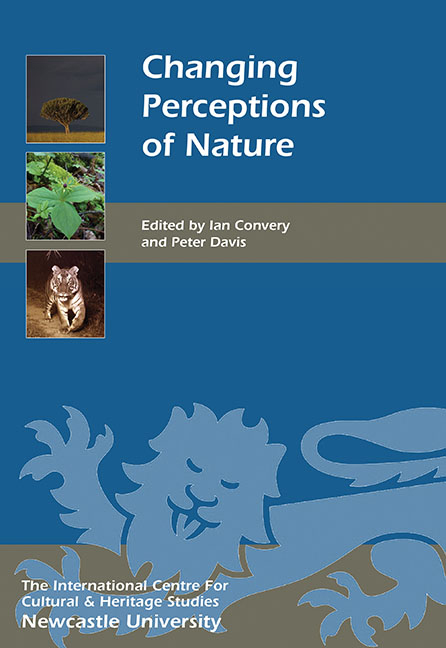Book contents
- Frontmatter
- Contents
- List of Illustrations
- Acknowledgments
- List of Abbreviations
- Foreword
- Introduction
- HISTORICAL PERSPECTIVES ON NATURE
- COLLECTING NATURE
- INTERPRETING NATURE AND LANDSCAPES
- CONSERVING NATURE
- PEOPLE–NATURE INTERACTIONS
- 22 Adventure, Nature and Commodification
- 23 Destination Nature: Wildlife and the Rise of Domestic Ecotourism in Britain, 1880–2015
- 24 Wild Places as Therapeutic Environments
- 25 Citizen Science and the Perception of Nature
- 26 Using Community-based Cultural Tourism to Enhance Nature Conservation in the Rupununi, Guyana
- 27 Representing Natural Heritage in Digital Space: from the National Museum of Natural History to Inuvialuit Living History
- 28 Out of the Wild Wood and into our Beds: the Evolutionary History of Teddy Bears and the Natural Selection of Deadly Cuteness
- 29 Rewilding: the Realisation and Reality of a New Challenge for Nature in the Twenty-first Century
- List of Contributors
- Index
- Miscellaneous Endmatter
22 - Adventure, Nature and Commodification
from PEOPLE–NATURE INTERACTIONS
Published online by Cambridge University Press: 26 October 2017
- Frontmatter
- Contents
- List of Illustrations
- Acknowledgments
- List of Abbreviations
- Foreword
- Introduction
- HISTORICAL PERSPECTIVES ON NATURE
- COLLECTING NATURE
- INTERPRETING NATURE AND LANDSCAPES
- CONSERVING NATURE
- PEOPLE–NATURE INTERACTIONS
- 22 Adventure, Nature and Commodification
- 23 Destination Nature: Wildlife and the Rise of Domestic Ecotourism in Britain, 1880–2015
- 24 Wild Places as Therapeutic Environments
- 25 Citizen Science and the Perception of Nature
- 26 Using Community-based Cultural Tourism to Enhance Nature Conservation in the Rupununi, Guyana
- 27 Representing Natural Heritage in Digital Space: from the National Museum of Natural History to Inuvialuit Living History
- 28 Out of the Wild Wood and into our Beds: the Evolutionary History of Teddy Bears and the Natural Selection of Deadly Cuteness
- 29 Rewilding: the Realisation and Reality of a New Challenge for Nature in the Twenty-first Century
- List of Contributors
- Index
- Miscellaneous Endmatter
Summary
Many (though not all) adventures have nature-based orientations, but, when established as commodities defined as marketable products, they are premised on destinations that normally comprise a wealth of natural environments. Adventure ‘tourism’ as ‘guided commercial tours where the principal attraction is an outdoor activity that relies on features of the natural terrain, generally requir[ing] specialised sporting or similar equipment, and is exciting for the tour clients’ (Buckley 2006, 1) is part of the emerging genre of provision. It can be positioned alongside ‘nature tourism’ where the emphasis is on travelling to enjoy and understand undeveloped natural areas and/or ‘wildlife tourism’, or ‘ecotourism’, which includes overtly educative and sustainability components. It is the interplay of adventure, nature and their emergence and manifestations through the concept of tourism that is the subject of this chapter.
Although definitions for ‘rational’ tourism (tourism with a purpose) are multifarious (see for example Swarbrooke et al 2011), one key defining factor is that they are activities that are entered into voluntarily. Adventure tourism has emerged from the outdoor recreation industry, which has been established for longer, with its roots in outdoor activities, journeying and expeditions. It is generally contextualised in environments that are rich in landscapes and are perceived to be relatively natural and unmodified, at least in historical times. The emphasis is on ‘adventure’, although this creates an interesting paradox when aligned with ‘tourism’ in that if ‘adventure’ relates to ‘uncertainty of outcome’ (Hopkins and Putnam 1993; Priest 1999), participants who are purchasing support often do so to reduce their perceived risk. Ecotourism is seen as a different subset, even though for many participants it may include an adventure, as they perceive it. It involves travel to a relatively pristine area with challenges to clients of the unknown. It is differentiated in the literature from adventure tourism in that the objective is to be immersed in that relatively undisturbed environment, to study and enjoy the landscape, flora and/or fauna as well as any cultural manifestations, past or present (Fennell 2003; 2015).
HISTORICAL PERSPECTIVE
Beyond the discovery of new territories, exploration focused on the polar regions (Scott and Shackleton, for example) and thence from conquering the highest mountains to aeronautical and space exploration.
- Type
- Chapter
- Information
- Changing Perceptions of Nature , pp. 227 - 234Publisher: Boydell & BrewerPrint publication year: 2016

